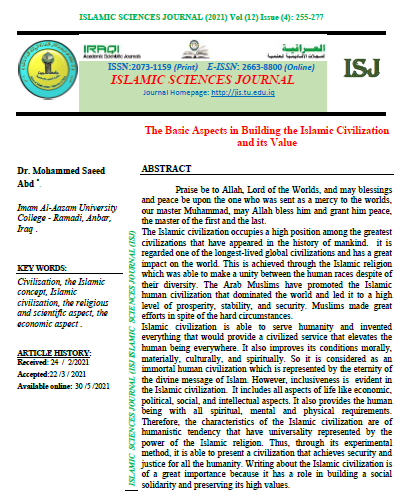The Basic Aspects in Building the Islamic Civilization and its Value
محتوى المقالة الرئيسي
الملخص
Praise be to Allah, Lord of the Worlds, and may blessings and peace be upon the one who was sent as a mercy to the worlds, our master Muhammad, may Allah bless him and grant him peace, the master of the first and the last.
The Islamic civilization occupies a high position among the greatest civilizations that have appeared in the history of mankind. it is regarded one of the longest-lived global civilizations and has a great impact on the world. This is achieved through the Islamic religion which was able to make a unity between the human races despite of their diversity. The Arab Muslims have promoted the Islamic human civilization that dominated the world and led it to a high level of prosperity, stability, and security. Muslims made great efforts in spite of the hard circumstances.
Islamic civilization is able to serve humanity and invented everything that would provide a civilized service that elevates the human being everywhere. It also improves its conditions morally, materially, culturally, and spiritually. So it is considered as an immortal human civilization which is represented by the eternity of the divine message of Islam. However, inclusiveness is evident in the Islamic civilization. It includes all aspects of life like economic, political, social, and intellectual aspects. It also provides the human being with all spiritual, mental and physical requirements. Therefore, the characteristics of the Islamic civilization are of humanistic tendency that have universality represented by the power of the Islamic religion. Thus, through its experimental method, it is able to present a civilization that achieves security and justice for all the humanity. Writing about the Islamic civilization is of a great importance because it has a role in building a social solidarity and preserving its high values.
تفاصيل المقالة

هذا العمل مرخص بموجب Creative Commons Attribution 4.0 International License.
COLLEGE OF ISLAMIC SCIENCES, TIKRIT UNIVERSITY. THIS IS AN OPEN ACCESS ARTICLE UNDER THE CC BY LICENSE http://creativecommons.org/licenses/by/4.0/

